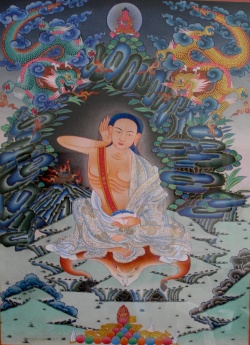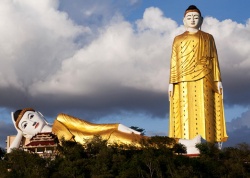The ''Other'' Emptiness
Submitted by Michael R. Sheehy on Thu, 2008-04-10 10:30
The technical Tibetan term "zhentong" (gzhan stong, often mis-phoneticized "shentong") suggests a particular view of reality, one that can be misconstrued due to the word itself. To give a simple gloss of the term, "zhentong" is: that which is empty (stong) of the other (gzhan).
The word is often translated into English as "other-emptiness," begging the question:
"Is there an 'other' emptiness?"
That is, an emptiness other than the one we all know and love?
To begin, the term "zhentong" was coined by the 14th century Kālachakra master and Jonangpa scholar, Dolpopa Sherab Gyaltsen who employed it to contextualize his understanding of the different descriptions of relative and ultimate reality as he read them within the sūtras, tantras, and their Indian commentaries.
Though it was most likely originally intended to signify some of the underlying tensions and paradoxes that he found within this Mahāyāna Buddhist literature, the word itself has come to be a signature of the view he articulated.
To further gloss the term, "zhentong" is: that which is empty (stong) of everything other (gzhan) than the very intrinsic nature of what is ultimate. However, this is placed in contrast to the term "rangtong" (rang stong): that which is empty (stong) of itself (rang) ― or the very intrinsic nature of what is relative.
This then leads to the obvious question: "Are there 2 kinds of emptiness?"
Well, yes.
The technical language found within zhentong literature conveys an interpretive model for distinguishing two definitions of emptiness:
(a) emptiness devoid of an intrinsic nature (*svabhāva-śūnyatā, rang stong), and what is empty of everything other than buddha-nature (*parabhāva-śūnyatā, gzhan stong).
This multivalent codification of śūnyatā and tathāgatagarbha is then spliced into (a) emptiness and (b) great emptiness (*mahāśūnyatā, stong pa chen po), referring to the ultimate emptiness that is permanently continuous.
In addressing this concern, Tāranātha poses the question:
"Some may wonder: Don’t the sūtras explain that even the expanse of phenomena is empty?
Response: In general, although there is what is empty and there is emptiness, these are not necessarily empty of an intrinsic nature.
Pristine awareness is known to be emptiness because it is empty of everything within the subject-object complex or of fabrications that are imbued with the qualities that consist of anything other than itself.
From Maitreya’s Madhyāntavibhaṇga it reads,
Erroneous conceptualizing exists.
In that state, duality does not exist.
In this state, emptiness exists.
In that state, this also exists.
What is not empty is not non-empty,
In this way, everything is explained.
Because there is existence,
There is non-existence,
Because there is existence.
This is the way of Madhyamaka."[1]
So, in this way, we see that there is in fact an "other" emptiness, and that this emptiness is empty of everything other than the other emptiness.
This post is part of a series of reflections on select topics found in "The Essence of Zhentong" (Gzhan stong snying po) by Tāranātha.
Endnotes:
1. Tāranātha. The Essence of Zhentong. Translated by Michael R. Sheehy. In Jonang Foundation's Digital Library, www.jonangfoundation.org/translations, 2008.

